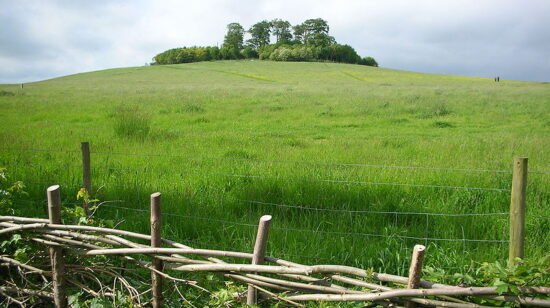
Gardens were at the heart of Tudor life; from the smallest cottage to the most glamorous royal palace, Tudor homes were surrounded by culinary, medicinal, domestic and ornamental plants and flowers. Fields and hedgerows brimmed with wildflowers and nature played an important part in the works of the two greatest poets of the age, Shakespeare and Spenser. And in their eyes, plants were often more than just pretty or useful; they were also imbued with meaning, symbolising emotions, or even elements of the Christian faith.
The increase in global trade also brought new ‘exotics’ to Europe, eagerly pounced upon by the royal courtiers who wanted to impress Queen Elizabeth by creating ever more fabulous gardens for her to enjoy as she went on her annual summer progresses, visiting towns, villages, and nobles around the country.
Thanks to her famous love of gardens, they became places to feast, to entertain, and to create elaborate displays of wealth – miniature wonderlands that one could easily get lost in. The devastating thing is that for all their beauty, hardly any Tudor gardens survive. Most were destroyed and most of what we know comes from a few historical drawings and descriptions.
But there is hope! This summer, DigVentures is crowdfunding an archaeological excavation to unearth the recently discovered remains of one of England’s last surviving Tudor gardens at Sudeley Castle. And, on top of that, Tudor Times have just published The Tudor Book of the Garden – now available to buy.
To celebrate, here are six plants that every Tudor gardener would recognise, and that you can still plant today to create your own Tudor garden:
Violets or violas – Viola odorata

Viola odorata © Tudor Times Ltd 2019
Beloved of Shakespeare, the humble violet (Viola odorata) appears in several plays as does its slightly more sophisticated cousin ‘heart’s-ease’ or Viola tricolor, that we call pansy. The viola emerges in early spring, in woodland. They were used for culinary purposes, as well as in cosmetic preparations and Viola tricolor was used for chest complaints.
Rosemary – Rosemarinus officinalis

Rosemarinus officinalis © Tudor Times Ltd 2019
One of the most useful of all plants in the Tudor garden, rosemary is ideal for cooking, for cosmetics and is also medicinal. For Ophelia, in ‘Hamlet’, it was also for remembrance. It will grow practically anywhere, and roots easily from cuttings. Keep pruning, lest it become woody.
Leeks – Allium ampeloprasum

Leeks © Tudor Times Ltd.
Leeks were a staple of the mediaeval and Tudor diet, important for the table in winter and early spring. They were named in the list of 72 essential plants, by Thomas Tusser, who wrote the most popular gardening books of the age. They are still delicious today, and are easy to grow – although they are best started in a seed-bed away from other crops, as they take up lots of room.
Brassica – Brassica oleracea

Brassica was a staple in the Tudor diet – cabbage and colewort or kale, being particularly widespread. We have a far wider range, but spring greens, a cultivar of Brassica oleracea, are probably close to the greens that would have graced the Tudor table.
Rose – Rosa

Rosa eglanteria © Tudor Times Ltd
On a more ornamental note, roses were firm favourites then, as they are now. Rosa gallica var. officinalis was ornamental, cosmetic and culinary – rose-hip tea was also medicinal. They were also symbolic – the red rose of Lancaster Rosa gallica var. officinalis and the white rose of York Rosa ‘alba semiplena’ were combined to create the Tudor rose. The wild rose or sweetbrier – Rosa eglanteria appears frequently in Shakespeare. It reaches a tremendous height – grown as a hedge, it is impenetrable.
Foxglove – Digitalis purperea

Digitalis purperea © Tudor Times Ltd
Another colourful note in the Tudor medicinal garden was the foxglove – it was used for heart complaints, and is still the basis of modern heart medicine – but beware of this one, it is highly poisonous.
Paeony – Paeonia officinalis

Paeonia officinalis and Aquilegia vulgaris © Tudor Times Ltd
One of the most vivid plants in the Tudor garden was the paeony, or pionée, as they called it. As well as its beauty, it was appreciated for its medicinal purpose as a treatment for the ‘falling sickness (epilepsy). Pictured here with another Shakespearian favourite, the Aquilegia vulgaris or columbine.
Information on these plants, and many others, can be found in the “Tudor Book of the Garden” by Tudor Times, a practical garden journal which combines dedicated sections for the modern gardener with extensive information on Tudor gardens and gardeners.
As well as sections on essential Tudor plants, tools, plants found in Shakespeare and popular Tudor gardening books, all of which would be familiar to the Tudor gardener, it has month and year planners and sections for the modern gardener to make notes on their own garden, its layout, best features and favourite plants. There is also information on restored or recreated Tudor gardens that can be visited in the UK.
“Tudor Book of the Garden” is published on 18 April 2019. Click here to read more or to buy a copy http://bit.ly/2Y62gcp
Love archaeology?
DigVentures was born from a mission: to connect people who love archaeology with opportunities to DO archaeology. Together, we're making groundbreaking new discoveries that everyone can be part of, and creating archaeology content that we can all share, learn from and enjoy. Wherever you live and whatever your background, you can be part of it too.
Become a Subscriber







There are no comments on this post yet. Be the first!